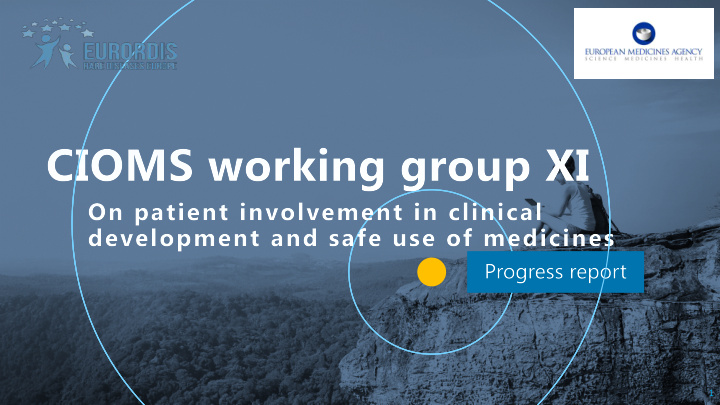



1
Founded in 1949 by WHO and UNESCO 2
CIOMS members https://cioms.ch/cioms-members !
Pharmacovigilance Bioethics Drug development 4
Working Groups – core of CIOMS 5
Working group XI (+ Nikos, Kaisa, Kerry) total 49 members !
Scope 1. European AIDS Treatment 1. International Society of 1. Medicines Evaluation Board Group (EATG) Pharmacovigilance (ISOP) (MEB) 2. European Organisation for 2. Netherlands 2. Health Canada Rare Diseases (EURORDIS) Pharmacovigilance Centre 3. Pharmaceuticals and Medical Lareb 3. European Patients’ Forum Devices Agency (PMDA) (EPF) 3. Uppsala Monitoring Centre 4. European Medicines Agency (UMC) 4. International Alliance of (EMA) Patients' Organizations 4. Center for Medicine in the 5. U.S. FDA (IAPO) Public Interest (CMPI) 6. MHRA 5. Alström Syndrome UK 5. Leeds University, U.K. 7. Health Products Regulatory 6. National Health Council, U.S. 6. World Medical Association Authority (HPRA) 8. Swissmedic 9. (CFDA China) 7
Scope 1. Roche 9. Bristol-Myers Squibb 1. Secretary-General 2. Takeda 10. Pfizer 2. Senior Advisor 3. IQVIA 11. Amgen Inc. 3. Technical writer 4. Merck 12. Novartis 4. WHO: Safety and Vigilance Team (SAV) 5. Janssen 13. Bayer AG 6. GSK 14. United Therapeutics 7. Eli Lilly 8. AbbVie 8
Objec ectiv ives a s and t timeline lines 1 2 3 4 5 9
Overview of the proposedCIOMS guidance Kerry Leeson-Beevers National Development Manager Alström Syndrome UK 10
T able of content - Princip iples les of p patien ient involv olvem emen ent (group oup 1) chapters 1 2 3 4 5 11
T able of content - Patien ient i involv olvem ement ent i in p pharmacov ovig igil ilanc nce a e and risk manage ma geme ment, g guidi ding p g princi cipl ples f for ( (group 2 p 2) chapters 6 7 8 9 10 12
Some i So issu ssues 1. Need for a global guidance 1. Transparency and conflicts of 1. Are there examples where Interests patient involvement has led to R ecognise diversity, and free of cultural bias better products? 2. Using patient data to evaluate 2. Challenges in low-and middle the benefits and risks of 2. Buy-in from stakeholder income countries (LMIC) medicines groups Different methods Will help in disseminating / 3. Who is “the patient”, and how implementing the guidance Data dividend / monetary value can fair representation be of patient data achieved? Re-identification issues Patients with diseases of poverty, depression or chronic conditions of old age are not well represented. The stigma of some diseases may 13 also prevent patient involvement
Fu Future w work rk Specific areas of ethical Change management approaches 1. Considerations for companies specific to overcoming of different sizes and available principles to be further explored barriers/resistance to patient resources and possibly documented in involvement in drug development guidelines or other resource 2. Further work into translating organisations documents measures of success for patient involvement into monetary value / return 14
How could PCWP share their opinion? Is there a need for a larger patient survey to explore some hypothesis? Or another method? Other experiences of patient advocacy in other regions than US and EU, or publications not in English: do you have references? CIOMS, ICH, and EMA own guidelines and their revisions, IMI PARADIGM: how to streamline?
THANK TH NK Y YOU E URORDIS | Information and Access
Recommend
More recommend